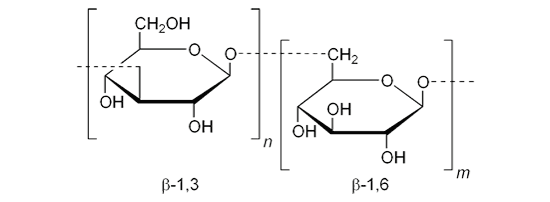β-glucans
Traditional measures to ameliorate weaning-associated intestinal dysfunction in pigs have focused on dietary manipulations post-weaning. However, recent research has indicated that supplementation of the maternal diet with β-glucans (Leonard et al., 2010, 2011) may influence growth performance and gastrointestinal physiology of weaned pigs. The use of natural supplements, such as β-glucans, is currently under consideration as an alternative to in-feed antibiotics.
β-glucans are a heterogeneous group of glucose polymers which form the main constituent of the cell walls of cereals, fungi, macroalgae and a limited number of bacteria. As well as being considered as a source of dietary fibre in monogastric nutrition, β-glucans also have distinctive immunomodulatory characteristics. The β-glucans in barley and oats are similar in structure but they can differ in the ratio of β-(1-3) and β-(1-4) linkages. The β-glucans in yeast and macroalgae are polysaccharides characterized by a basic structure of chains of glucose molecules that have a β-(1,3) linked backbone and 1,6 linked branches. The chemical structure of laminarin consists mainly of a linear β- (1 → 3) - linked glucan with some random β- (1 → 6) - linked side-chains depending on the variety of seaweed.

Feeding Sows during lactation
Recent research (Leonard et al., 2010, 2011) investigated the application of nutritional strategies to the maternal diet on manipulating gastrointestinal physiology and immune status of the weaned pig. In addition, the effect of maternal dietary treatment on growth performance of the pre- and post-weaned pig was investigated. Nutritionally, these effects were induced by supplementing the late gestation and lactating sow diet with polysaccharides derived from seaweed. The seaweed extract (SWE) consisted of laminarin, an algal source of β-glucans and the highly sulphated fucoidans.
The effect of maternal SWE supplementation on suckling piglet performance indicated that overall daily gain during the suckling period and average weaning weight were not influenced by dietary treatment. However, pigs weaned from SWE-supplemented sows had a higher average daily gain between d 0-21 post-weaning.
Immunity
Dietary SWE supplementation from day 109 of gestation enhanced colostrum IgG and milk protein concentrations on day 12 of lactation. Furthermore, piglets suckling SWE-supplemented sows had greater circulatory IgG and IgA concentrations on day 5 and IgG concentrations on day 12 of lactation indicating an enhancement of humoral immune function against potential pathogens.

The phagocytic activity of piglet serum white blood cells against E. coli at weaning was influenced by sow dietary treatment. Maternal dietary SWE enhanced leukocyte phagocytosis at weaning. Phagocytosis is an essential component of host immunity responsible for detection and elimination of invading pathogens. These observations indicate an enhancement of cellular immunity.
Microbiology
Dietary SWE supplementation also decreased sow faecal Enterobactericeae populations on the expected delivery date indicating an antibacterial effect of the SWE extract. Furthermore, piglets suckling SWE-supplemented sows had decreased colonic E. coli numbers at weaning. Numerous studies have demonstrated that dietary provision of laminarin and fucoidan decreased faecal Enterobacteriaceae and enteric E. coli populations in pigs (Reilly et al., 2008, McDonnell et al., 2010, Lynch et al., 2009). A suppressed colonic E. coli population at weaning may help alleviate the incidence of post-weaning diarrhoea.
In addition, this work investigated the effect of maternal SWE supplementation from d 109 until weaning on small intestinal morphology and selected microflora 9 days after weaning.
This experiment indicated that pigs weaned from SWE supplemented sows harboured a decreased caecal E. coli population 9 days after weaning. Furthermore, pigs weaned from SWE-supplemented sows had a reduced total bacterial load in the colon 9 days after weaning characterized by reduced Bifidobacteria spp., reduced Lactobacilli spp. and E. coli numbers. This suggests a broad spectrum anti-bacterial property of the extract (laminarin-fucoidan mix). Similarly, an increase in villous height to crypt depth ratio in the ileum and jejunum mucosal surface was observed in pigs weaned from SWE supplemented sows 9 days after weaning. The villous height to crypt ratio has previously been described an important indicator of gut health. It is conceivable that improvements in small intestinal morphology may partially relate to a reduced E. coli population.
Collectively, these results demonstrate that maternal laminarin and fucoidan supplementation failed to influence average piglet weaning weight despite an enhancement of humoral immune function during the suckling period. However, maternal laminarin and fucoidan supplementation promoted growth performance of weaned pigs between d 0-21 post-weaning. Results indicate that piglets suckling SWE-supplemented sows had an enhanced humoral immunity, greater percentage positive of E. coli phagocytising leukocytes and suppressed colonic E. coli population. The observed improvements in starter pig performance may be attributed to improvements in immune function and gastrointestinal microflora at weaning.



